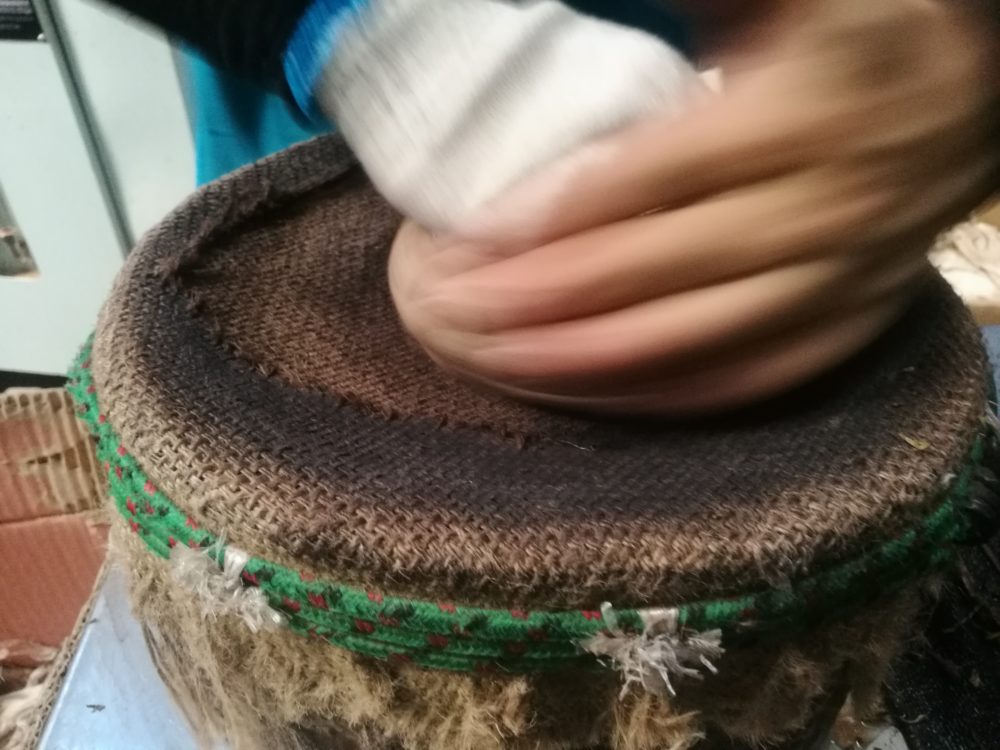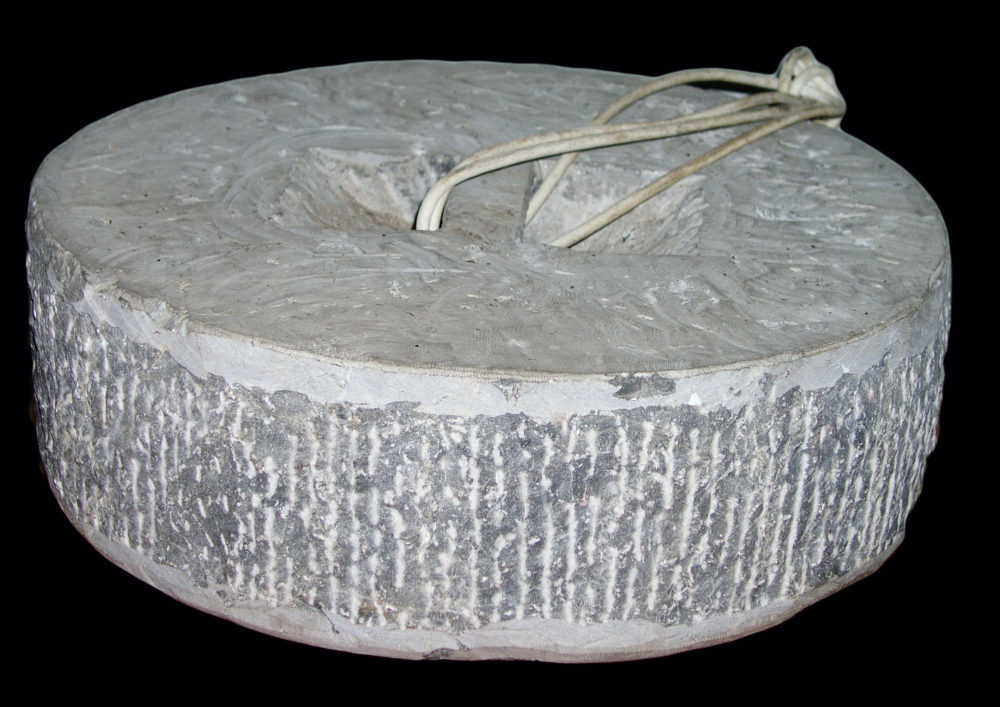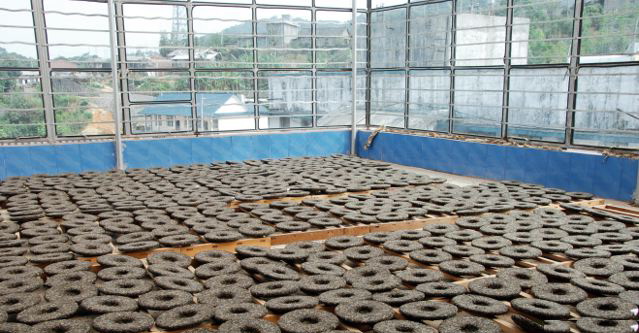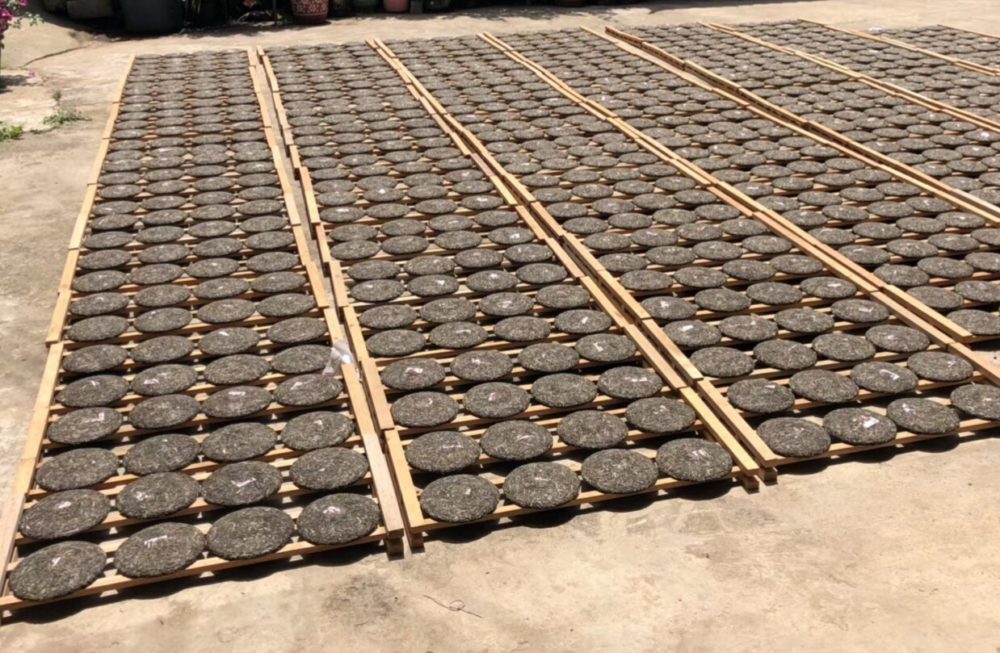In the world of Puer tea, opinions are not in short supply. How you get your cakes pressed is a case in point. There’s some logic behind the arguments, but it’s also about trends. Like how tight you wear your jeans, if you’ll excuse the analogy. One year loose fit is in vogue, the next straight, the next tight. It comes and goes.
Before we even get that far, how long one waits before pressing tea is another contentious issue. Generally speaking, the rule of thumb is to wait a month or so before pressing mao cha. The tea has just been made and dried in the sun and is going through a period of significant change and, the argument goes, is best left some time to stabilise. Plenty of folks wait longer. Some at least a year. But if you’re not living locally and need to get back home with tea in hand, or you need to get your product on the shelves, waiting longer may be a luxury you can’t afford.
Many local folks will wait at least till Autumn. This has the added benefit of avoiding the rush that occurs at this time of year, when many pressing outfits have waiting lists of at least a couple of weeks. In recent years, the wait time has perhaps been exacerbated by more people pressing smaller quantities of tea, and pressing smaller cakes, like 200 or 250 grams, which slows the process down.
Tea pressing factories prefer 357 g cakes as the other, smaller pressing options are more fiddly and slow (and the costs go up accordingly). But people who’ve got lesser quantities of tea are more likely to choose these options irrespective of costs. Of course, the much bigger tea companies are likely pressing their own tea anyway. Some people stick to 357 cakes because ‘that’s the tradition’ though the history of that is debatable. Some people go for 400g cakes or another variation, but still using the 357 bags, because they say it looks more ‘ba qi’ than 357. It’s true, kind of. The extra fifty odd grams definitely makes the cake look more plump.
The earlier idea – that bricks were made from junky tea – has been turned on it’s head in recent years with many people pressing 250, 500, or even 1kg bricks but using exactly the same material as cakes.
The process of pressing tea is essentially this:
The loose tea is weighed out (sometimes adding a few grams more to account for loss of weight through drying in the future), put it into the cylindrical container that will be put over the steamer, the ‘nei fei’ if there is one, is put under a few of the leaves on top (it will end up in the bottom of the bag once the tea is turned out of the container), and it’s steamed.
Nobody much talks about the water used, though it maybe has some small but discernable impact on the tea. Whatever the water, we’re only interested in the vapour in any case, so unless there are contaminants in the water that will vapourise, there should be no need to worry.
Steaming is generally for 20-30 seconds. If tea is steamed for too long – it happens occasionally if someone gets distracted, or there is a problem in the production process – it can subsequently have a rather dull appearance.
The pressure of the steam is important because one wants the steam to penetrate the leaves entirely and uniformly and also fairly quickly. Sometimes tea is steamed a second time if, in forming the shape, it has already cooled down too much to be workable, so it is steamed briefly again whilst still in the bag.
Some people like to use a hand operated or hydraulic press to lightly press the tea before putting it under a stone. This can help give the cake a more regular appearance and maybe saves having to stand on the stone, for added compression otherwise, significant amounts of tea are stone pressed. A team of 3 people can press oabout 300 kilos of 357 cakes in a day but around half of that for 200g cakes.
Stones vary in size, but generally are about 20cm tall and 30+ in diameter. The person doing the pressing stage of the work will generally stand on the stone and do ‘the hoola hoop’ 3 or 4 times. What one wants is a fairly uniform compression with the outside edge tight enough that the cakes is not going to fall apart at the edges.
There’s been something of a trend in the last couple of years amongst some folks who have been going for a tighter pressing. The logic is that the tea ages more slowly and therefor keeps its fragrance better than in a looser cake which tends to lose more of the aromatic properties more quickly.
Another reason that is typically sighted for tighter pressings is when the tea is not intended for consumption when young and is to be kept several years for ageing. With that is the added factor of the nature of the planned storage: More humid storage could well use tighter pressings than dryer because the tea will age and loosen up more quickly.
A third idea is that blended cakes work better with a tighter pressing because the oils, etc. from the leaves are going to blend together more as they’re squeezed out giving a smoother drinking experience.
None of that is particularly contentious. The big area of discussion, and disagreement, is on drying. Here, opinions can get pretty polarised. There are broadly three schools of thought. The advocates of each say something along the lines of the following:
1. Tea must be dried in a drying room. The temperature is controlled, and is in the low to mid 40’s ). The temperature can be controlled so that it is lower than that of cakes drying in the sun. Air drying tea runs the risk of the tea going mouldy inside if not properly dry. Sun dried tea runs the risk of producing a sour flavour and the ultra-violet light can have a detrimental effect on the enzymes which are needed for the tea to age well.
2. Tea must be air dried. Historically, tea was not dried in a drying room dried. If the temperature is too high in a drying room it is detrimental to the tea. Room dried tea is initially quite fragrant, but for longer term storage air dried is better. If it is dried properly it will not run the risk of going mouldy.
3. Tea must be dried in the sun. Traditionally, pressed Puer tea was sun dried. Waiting till the winter when the sun is not so fierce is better. Tea needs to be air dried for a couple of days before being put in the sun to avoid it becoming misshapen, but it should be dried in the sun at a high enough temperature and for long enough for much of the moisture inside the cake to evaporate – that could be half an hour, or a couple of hours. Too long and the tea risks being damaged. Tea can also be dried in a ‘da peng‘, a perspex roofed drying platform such as is sometimes used for drying mao cha, but many people would not see that as an ideal option.
And then there are the ‘it depends’ folks:
It depends where and when the tea is being pressed: a little sun in the early morning may be OK. If the weather is inclement you may have no choice but to room dry.
People pressing in Jinghong will often favour room dried tea, because it’s also related to time and place. Jinghong is lower altitude (600m) and more humid than Yiwu or Menghai, for example. They also maybe don’t have a great deal of space to dry any other way. (tea that’s put outside to sun dry would take up a fraction of the space when stacked in a drying room.
People in Yiwu and Xiangming seem to favour sun-drying whilst Menghai folks tend to favour room-drying. This is maybe also to do with the different sizes of the pressing factories. Menghai probably has more large scale pressing operations.
It depends on the season: Air drying is possible into May, but later on, there is no choice but to room dry because of rainy season humidity. The risk of mould developing in tea that has not been properly dried is too great.
It also depends where the tea is being sent: if the tea is air dried and sent somewhere dry, it may be OK, but if sent somewhere more humid, it may be a problem.
It depends if you’ve got time. Room drying takes a couple of days. Natural drying can take several days, so if you’re in a rush to get your tea dried so you can ship it to wherever, natural drying may not be an option. Also larger scale outfits are probably less inclined to air dry because of time constraints.
I’m pretty much in the ‘it depends’ camp. My preference is for air-dried cakes. I have sometimes put air-dried tea outside in early morning/dappled sun for a few hours. If one is not in a hurry, that seems like the best option to me. I have never tried full-on sun drying and don’t feel tempted to try , though I know people who do. If it’s done judiciously it may well be OK, and may even be beneficial, but I doubt anything over an hour or two is good if the sun is hot. Given that ultra violet light clearly has sterilizing properties, and it seems quite probable that it would affect, if not damage the enzymes in Puer. Using a drying room, if done judiciously, is probably OK too.
Most pressing places are small factory type set-ups with sheet steel roofing. They get pretty hot inside. Because steam is being used, they also get pretty humid. Drying room temperature is important, but certainly controllable. I am more concerned with what sort of exhaust system a drying room has: having 40+ degrees of heat is certainly not a problem (if you put cakes outside with an air temperature of upper 30s, they will surely get that hot. If you put them in the sun, even hotter), but making sure that moisture is extracted efficiently is important. So choosing the right place at the right time of year is important: At this time of year with waiting times of two weeks or so, if they are not reliable, it may be tempting for a pressing outfit to push their temperatures up a little in order to speed up the process. That would not be desirable.
These days, a typical practice for deciding when pressed cakes are dry is to weigh them, or rather weigh two or three from a batch. The weight can be compared with the weight of the mao cha weighed out for steaming.





